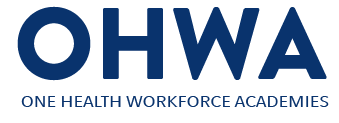COBERMS
1.) Please select Network:
AFROHUN
2.) AFROHUN – Please select OHUN or Country:
UGANDA
2.1) UGANDA – Please select a University:
Mbarara University of Science and Technology, Faculty of Medicine
3. What is the specific title of the One Health training and empowerment activity?:
COBERMS
4. What is the code number associated with this activity (i.e.in the University’s Catalogue used to enroll in the activity)?:
COB
5. Trainee Workload: What are the number of credits or units awarded for completion of the training activity?:
4
6. Who is the target audience (types of trainees) for this One Health training and Empowerment activity?:
Pre-service training (Undergraduates or Bachelors)
7. Learning Objective: What are the One Health Competency domains presented for this training and empowerment activity?:
One Health Principles and Concepts
Outbreak Investigation and Response
One Health Epidemiology
One Health Research
One Health Collaboration and Partnership
One Health Communication and Informatics
Gender and One Health
Behavior Change (One Health Perspective)
Culture, Beliefs, Values and Ethics (One Health Perspective)
Environment and One Health
8. Learning Outcomes: What is the Expected level of Competence for Trainees who complete the One Health training and empowerment activity?:
Novice or Beginner
9. What is the method of delivery of the training activity (Engagement of trainees)?:
Other (specify)
9.1 Please Specify:
Field attachment and experiential learning
10. Curriculum Design: Is the training activity designed to deliver knowledge of One Health topics or is the emphasis on the level of competencies, or both?:
Competency-based: The syllabus is designed to bring the learner to a new competency level, making them more desirable for future employment.
11. What Teaching Strategies are used?:
Problem or case-based learning (e.g. case studies)
Work-based learning (e.g. through real life work experiences)
Student-led learning (e.g. group projects)
12. What is the period of time allocated to the training and empowerment activity?:
Months
12.2 Number of months allocated to the training and empowerment activity:
12 months
13. What is the period of time expected for the instructor (lecturer, faculty member, and teaching assistants) to deliver instruction to the trainee(s)?:
Weeks
13.3 Number of weeks expected for the instructor to deliver instruction to the trainee(s):
4
14. What are the number of hours of study (outside of direct classroom or virtual instruction) required, including private or group study time, homework, required readings, projects and field practice per week?:
36
15. Are there pre-requisites for the training activity?:
Yes
16. Please describe or list the pre-requisites.:
Students who are in second year of study are the one eligible
17. What is the approximate minimum # of trainees who enroll in this activity each time it is offered?:
120
18. How many times a year is this training and empowerment activity offered?:
1
20. Is there a minimum passing score for the course?:
Yes
21. In general, what is the proportion of trainees who pass each time the training and empowerment activity was offered?:
71
22. Please provide the type of evaluation tool used to assess how well the instructor, lecturer, or faculty member performed in delivering the training activity to trainees.:
Direct supervisor observation
Trainee feedback
23. If there is Trainee feedback (answered in 20), please provide the type of evaluation for trainees to assess the quality of the training and empowerment activity.:
Meetings/debrief
External assessment
24. Are trainees who completed the training activity (alumni) tracked to assess if and how they use knowledge gained and competencies acquired in their employment situation?:
Yes
25. What is the process used to contact and obtain information from trainees who complete the training and empowerment activity (alumni)?:
Through reports and future activities related to One Health
26. Is there extramural funding support for offering the training activity?:
Yes
27. Please indicate how the course is funded::
University resources
28. Is the training activity offered to non-university students?:
No
29. Is the training and empowerment activity documented in the official University catalogue?:
Yes
30. If available, please provide a web link to the training/course.:
https://www.google.com/search?q=coberms+Mbarars+university&rlz=1C1JZAP_enUG809UG822&oq=coberms+Mbarars+university&aqs=chrome..69i57j0i333l4.18524j0j4&sourceid=chrome&ie=UTF-8
31. Is this course approved for Continuing Professional Development (CPD) credits or hours?:
No
32. Are there new One Health-focused training activities being developed for future offerings at the University?:
No
33. Are there One health-focused training activities that will be discontinued in the near future (i.e. next year)?:
No
34. Please share any final comments about the One Health training activity.:
This program is a flagship program for Mbarara University.
35. Is a syllabus (curriculum for the specific training and empowerment activity) available to upload on this website?:
Yes, and I can upload it now
37. Thank you for sharing. Please upload the syllabus here::
https://s3.us-east-1.wasabisys.com/owha-sample-bucket/2021/07/LCP-Curriculum-1-b6756d04c0680b47cc350d30a17c9722.pdf
38. Are there other training documents available that you are able to upload on this platform (e.g. curriculum document, competency framework, assessment tool, grading rubric, and others)?:
No
41. Are there any comments that you would like to share?:
none
42. Do you have another training and empowerment activity in this category?:
No
